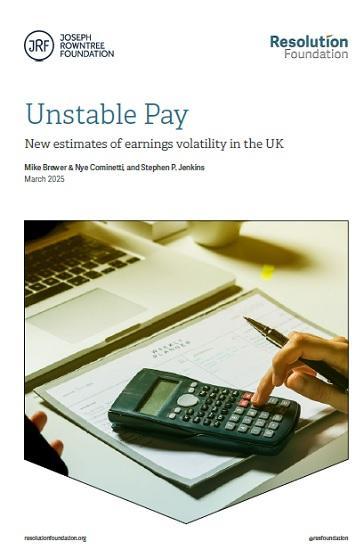Unstable Pay - New estimates of earnings volatility in the UK
9th March 2025

This report uses a newly available dataset - payroll data held by HM Revenue and Customs on over 250,000 working-age people covering April 2014 to March 2019 - to look at monthly and weekly volatility in employee pre-tax earnings. It is one of a very few UK studies to look at high-frequency earnings volatility on a large scale, and the first do so on a sample that is representative of the population of employees in the UK.
Earnings volatility will not pose problems for all workers (for example, if erratic earnings are the minority of a household's income, or if they are the side effect of being able to take shifts that fit around other parts of a worker's life). But unpredictable earnings can mean financial stress, difficulty planning for the future, and increased reliance on credit or social support. So understanding earnings volatility is crucial for building fairer labour markets, effective social policies, and financial security in an uncertain world.
Key findings
Among those employed in consecutive months, 29 per cent saw their earnings change by up to 10 per cent; another one-in-eight (13 per cent) saw changes of up to 25 per cent; and a further 15 per cent saw changes of more than 25 per cent. By contrast, only four-in-ten (43 per cent) workers saw effectively no change in monthly earnings.
Some earnings volatility will be due to pay rises. Volatility peaks in March (the most common month for rises in pay) and April (the most common month for falls in pay). For employees in Finance and Insurance, earnings in March average 37 per cent higher than February, in line with other data that suggests that more than half (55 per cent) of total remuneration in the sector in March reflected bonuses.
Individuals' experiences of volatility can also be summarised by looking at patterns of changes in monthly earnings experienced over a year. Among people consistently employed, only one-in-four (26 per cent, or 5.0 million) experience ‘stable' pay - defined as having monthly earnings within 10 per cent of their average monthly wage in all months of the year. Around one-in-seven (14 per cent, or 2.7 million) employees experience ‘erratic' earnings across the year - defined as having four or more months in a year where their earnings are at least 25 per cent higher or lower than their average monthly wage.
One-in-four (24 per cent) consistently employed 20-24-year-olds having erratic pay in a year, more than twice the rate for those aged 40 and over (10 per cent). Erratic earnings are most common in hospitality (27 per cent of employees), arts and recreation (23 per cent), retail (16 per cent), banking (16 per cent) and health and social care (14 per cent) sectors. Other than banking, this list is similar to the sectors that make the greatest use of zero-hours contracts: pubs and restaurants; accommodation; entertainment and recreation; and social care.
Erratic pay is most common among the lowest earners and highest earners. It is also more common among those with temporary contracts and those working part time (as recorded in April of that financial year).
Workers paid weekly, who are predominately in low-paid sectors, experience even greater volatility, with an average week-to-week earnings change of 19 per cent, with 7 per cent seeing a weekly change of at least 25 per cent.
Read the full report HERE
PDF 57 Pages
